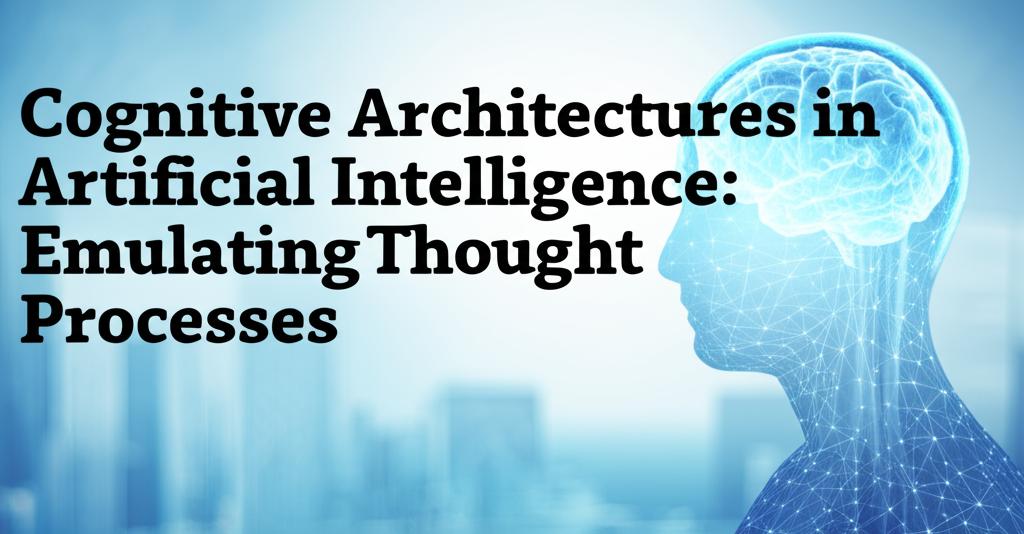Cognitive architectures in artificial intelligence aim to create systems that can reason, learn, and adapt in ways similar to the human mind. These frameworks provide a blueprint for AI agents, enabling them to process information, make decisions, and interact with their environment in increasingly human-like ways.
Core Concepts and Components:At its heart, a cognitive architecture is a theory about the structure of the human mind, computationally instantiated to build intelligent systems. These architectures typically include several core components that mimic human cognitive processes:
- Perception: This module enables the AI to gather and interpret information from its environment through various sensory inputs.
- Memory: Akin to human memory, this component involves both short-term (working) memory for holding and manipulating current information and long-term memory for storing knowledge and experiences.
- Reasoning and Decision-Making: These processes allow the AI to use its knowledge and perceptions to solve problems, make choices, and plan actions.
- Learning: Cognitive architectures often incorporate mechanisms for learning from experience, adapting their behavior, and improving performance over time.
Cognitive architectures can be broadly categorized:
- Symbolic Architectures: These classic architectures, such as ACT-R (Adaptive Control of Thought – Rational) and Soar, model human thought using explicit rules and structured knowledge. They break down cognition into manageable components that work together, often using "if-then" production rules to guide behavior. ACT-R, for example, uses specialized modules for different cognitive functions (visual processing, memory retrieval, etc.) that communicate through limited-capacity buffers. Soar focuses on problem-solving by defining problem spaces and using operators to navigate between states of knowledge, creating subgoals for complex challenges.
- Emergent (Connectionist) Architectures: In contrast to symbolic systems, emergent architectures, often based on neural networks, develop complex behaviors from the bottom up. Knowledge isn't explicitly programmed but emerges through experience and adaptation, mirroring how the human brain learns. These systems utilize parallel distributed processing.
- Hybrid Architectures: Recognizing the strengths and weaknesses of both symbolic and connectionist approaches, many modern efforts focus on hybrid architectures. These aim to combine the explicit reasoning capabilities of symbolic systems with the learning and pattern recognition strengths of neural networks. This dual-process approach often seeks to emulate both fast, intuitive thinking and slower, deliberate analytical thought.
The field of cognitive architectures is continuously evolving, with several key trends shaping its future:
- Integration with Foundation Models: Researchers are exploring ways to integrate cognitive architectures with large language models (LLMs) and other foundation models. The idea is to leverage the vast knowledge stored in foundation models while using the structured reasoning and learning capabilities of cognitive architectures to guide output, potentially making AI more relevant and even helping to detect when a model might be "hallucinating" or generating incorrect information.
- Sophisticated Learning and Memory: Advancements include more sophisticated memory systems and motivational frameworks, allowing AI to maintain contextual understanding across scenarios and adapt to new situations. Reinforcement learning mechanisms are being integrated to enable systems to learn from both successes and failures.
- Explainability and Trust: A significant advantage of some cognitive architectures is their potential for improved explainability in AI decision-making. By modeling human-like attention, memory, and reasoning, these systems can offer more transparent insights into their processes, which is crucial for applications in areas like healthcare and finance.
- Collective Intelligence: The emergence of collective intelligence in multi-agent systems is another significant trend, where multiple AI agents collaborate and learn together.
- Neuro-Symbolic AI: This hybrid approach, combining symbolic reasoning with neural networks, is gaining traction, particularly for applications requiring both data-driven learning and human-interpretable knowledge, such as personalized mental health therapy.
- Developmental Robotics and Embodied Cognition: There's a growing understanding that intelligence is not just about disembodied computation but is also shaped by interaction with the physical and social environment. This has led to approaches like Artificial Cognition (ACo), grounded in Cognitive Neuroscience, which emphasizes proactive knowledge acquisition through human-robot interaction.
Cognitive architectures have practical applications across a wide array of fields:
- Robotics: Enabling autonomous navigation in complex environments and performing tasks that require human-like flexibility.
- Healthcare: Assisting in disease diagnosis, recommending treatments by mimicking diagnostic reasoning, and developing personalized mental health interventions.
- Autonomous Systems: Powering autonomous vehicles to navigate complex traffic scenarios and drones for rescue missions.
- Human-AI Interaction: Creating AI assistants capable of more natural and context-aware conversations.
- Education: Developing adaptive learning platforms that can tailor educational content to individual student needs and learning styles.
- Finance: Improving decision-making systems by providing more explainable AI.
Despite significant progress, challenges remain:
- Scalability: Building cognitive architectures that can handle the complexity and scale of real-world problems is an ongoing challenge.
- Integration: Seamlessly integrating diverse cognitive functions and different types of AI approaches (e.g., symbolic and sub-symbolic) remains a complex task.
- Bridging the Gap with Human Cognition: While the goal is to emulate human thought, fully replicating the nuances, flexibility, and common sense of human cognition is still a distant ambition. Higher-level functions like complex language understanding, reasoning, and planning remain particularly difficult.
- Data Requirements: Training robust cognitive models, especially those leveraging machine learning, often requires vast amounts of data.
- Ethical Considerations and Bias: As these systems become more sophisticated, ensuring they are free from bias and operate within ethical boundaries is paramount.
The future of cognitive architectures lies in developing more powerful, adaptable, and trustworthy AI systems. By incorporating insights from cognitive science, neuroscience, and psychology, and by fostering collaboration between academia and industry, researchers aim to create intelligent entities that can truly understand, learn, and evolve, potentially alongside humans. The ongoing refinement of these architectures could pave the way for significant breakthroughs in artificial general intelligence (AGI) – the quest to create machines with human-like cognitive abilities across a broad range of tasks.

